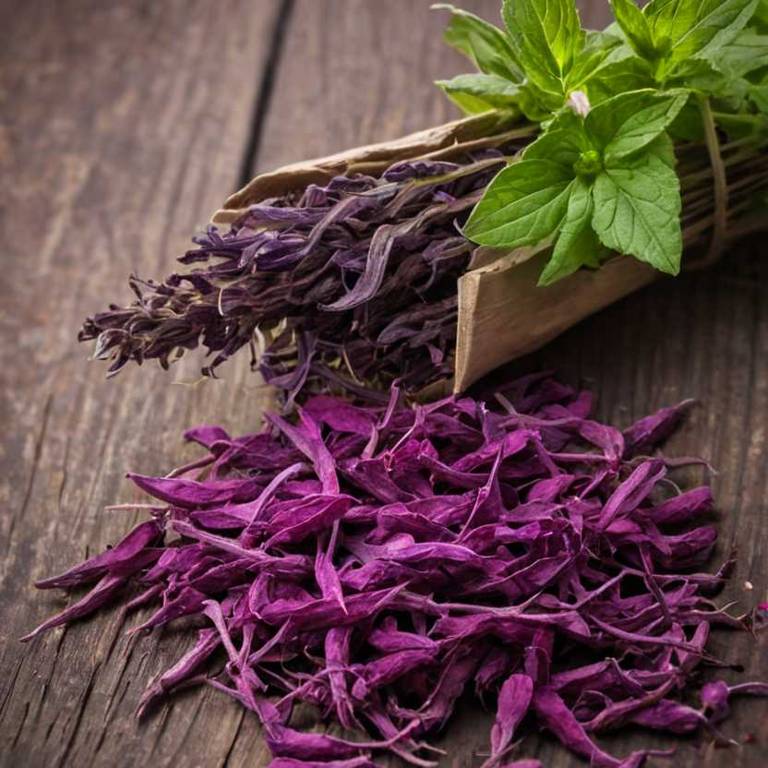Chinese Violet (Salvia Miltiorrhiza)
Information Reliability Score: 5/10
This score reflects the overall reliability of the information presented in this article. It is based on the quality of scientific evidence, accuracy of sources, and the transparency of references related to Salvia miltiorrhiza.

Chinese Violet, scientifically known as Salvia miltiorrhiza, is a medicinal herb widely used in traditional Chinese medicine for its potent health benefits.
It is renowned for its ability to improve blood circulation, reduce inflammation, and support heart health, making it a key adaptogen in herbal formulations. Historically, it has been used for centuries to treat conditions such as cardiovascular disease, menstrual disorders, and skin ailments, reflecting its deep-rooted cultural significance in Chinese herbal practices. In modern wellness, it is increasingly utilized in supplements and topical treatments for its antioxidant and neuroprotective properties.
One of its unique features is the presence of a rare active compound called tanshinone, which contributes to its distinctive red color and therapeutic effects.
FREE CHECKLIST
The Only 10 Herbs You Need to Heal 90% of Common Ailments.

Table of Contents
Scientific and Botanical Profile
Chinese Violet, with botanical name Salvia miltiorrhiza, is a perennial herbaceous plant belonging to the Lamiaceae family, commonly known as the mint family.
Native to regions such as China, Korea, Japan, Taiwan, Southeast Asia, the Eastern Himalayas, and Vietnam, it is also referred to by various common names including Red Sage, Purple Coneflower, Chinese Knotweed, and Bloodwort. Morphologically, it features square stems, opposite leaves that are lanceolate to ovate in shape, and showy violet to purple flowers that bloom in whorled clusters, giving it the nickname Purple Needle or Purple Gromwell.
Its roots, often called Salvia Root or Purple Root, are the primary part used in traditional medicine, and the plant is also known as Chinese Red Sage or Purple Ginseng due to its medicinal and cultural significance.
History and Cultural Relevance
Chinese Violet, or Salvia miltiorrhiza, was used for centuries in traditional Chinese medicine as a key herb for promoting blood circulation and treating various ailments.
Its roots, rich in compounds like tanshinone and salvianolic acid, have been valued for their anti-inflammatory, antioxidant, and cardioprotective properties. In ancient times, it was also incorporated into rituals and folk traditions, often used in ceremonies to ward off evil spirits and promote healing. Today, it remains a vital component in modern herbal formulations for conditions such as cardiovascular disease and stroke.
Its enduring cultural and medicinal significance highlights its role in both historical healing practices and contemporary health care.
Chemical Composition and Nutritional Profile
Chinese Violet contains a variety of bioactive compounds, including tanshinones, which are lipophilic compounds known for their antioxidant and anti-inflammatory properties, along with flavonoids such as quercetin and rutin, which contribute to its protective effects against oxidative stress.
It is also rich in essential oils, terpenes, and alkaloids, which play roles in modulating cellular processes and immune responses. Nutritionally, Chinese Violet provides small amounts of vitamins like vitamin C and B-complex vitamins, along with minerals such as iron, magnesium, and calcium, supporting overall metabolic function. The mechanism of action involves the activation of antioxidant enzymes, reduction of free radical damage, and modulation of inflammatory pathways, which may contribute to its traditional use in treating cardiovascular and neurological conditions.
Overall, its unique chemical composition and nutritional profile make it a valuable herb in both traditional and modern therapeutic applications.
Medicinal Properties and Health Benefits
Salvia miltiorrhiza has been widely recognized for its potent medicinal properties, particularly in traditional Chinese medicine, due to its rich content of active compounds like tanshinone and salvianolic acid.
It is known to support cardiovascular health by improving blood circulation, reducing inflammation, and preventing oxidative stress, which benefits the circulatory and nervous systems. Additionally, salvia miltiorrhiza exhibits anti-platelet aggregation effects, making it beneficial for preventing blood clots and supporting heart health. Compared to similar herbs like ginkgo biloba or curcuma, salvia miltiorrhiza offers more targeted support for the cardiovascular system and has a stronger evidence base for its effects on microcirculation and neuroprotection.
Its unique combination of bioactive compounds also contributes to its higher potency and broader therapeutic applications in modern herbal formulations.
Discover the 10 best health benefits of Chinese Violet.
Forms, Preparation and Usage
Salvia miltiorrhiza has been widely used in traditional medicine for its therapeutic properties, and it is available in various forms including fresh roots, dried roots, tincture, powder, essential oil, and capsules.
It can be prepared by making a tea by steeping the dried roots in hot water, or through decoction by boiling the roots for a longer period to extract its active compounds. Topical applications are also common, such as using the powder or essential oil directly on the skin for inflammatory conditions. The recommended dosage for adults is typically 1 to 3 grams of dried root per day, while for children, it should be used only under medical supervision.
Due to its potent nature, it is advised to use salvia miltiorrhiza sparingly, with a duration of no more than a few weeks unless directed by a healthcare professional.
Safety, Side Effects and Contraindications
Salvia miltiorrhiza can be a beneficial medicinal plant used for its potential cardiovascular, anti-inflammatory, and neuroprotective properties, but it must be used with caution due to its possible side effects and interactions.
Common side effects may include gastrointestinal discomfort, such as nausea and diarrhea, as well as allergic reactions in sensitive individuals. It may interact with anticoagulant medications, increasing the risk of bleeding, and may also interfere with other drugs, including chemotherapy agents and anticonvulsants. Pregnant and breastfeeding women should avoid salvia miltiorrhiza due to insufficient safety data, and individuals with chronic illnesses should consult a healthcare provider before use.
To ensure safety, it is advisable to use salvia miltiorrhiza under medical supervision, follow recommended dosages, and monitor for any adverse reactions.
Growing, Harvesting and Storage
Salvia miltiorrhiza grows best in well-drained, loamy soil with a slightly acidic to neutral pH, in full sun to partial shade, and requires regular watering to maintain consistent moisture without becoming waterlogged.
To ensure healthy growth, it benefits from annual fertilization with a balanced organic fertilizer and occasional pruning to promote bushier growth and prevent disease. Harvesting is most effective in the fall, when the roots are fully mature, and involves carefully digging up the plant with a spade or fork to avoid damaging the delicate roots. After harvesting, the roots should be thoroughly washed, cut into small pieces, and dried in a cool, dark place or in a dehydrator to preserve their potency.
Proper storage requires placing the dried roots in airtight containers and keeping them in a cool, dry location, away from light and moisture, to maintain their medicinal properties over time.